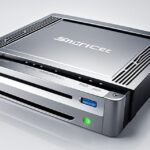Table of Contents
Access time is key when looking at how well a hard drive performs. It shows us how quick a hard drive can find and get a specific data piece. Thanks to tech getting better over time, hard drive access time has gotten much faster. We’ve gone from waiting about 600 milliseconds way back to now only about crossing out 9 milliseconds for the drives in our desktops. And it’s even faster for top-notch server drives, hitting around 4 milliseconds12.
This important time is measured in milliseconds. It shows how effective our storage options are. This is really important in areas where getting data quickly is key, like in gaming or when analysing data. Knowing and improving access time can make our experiences better and our systems run smoother. It’s something crucial to think about for anyone looking into storage tech today.
Key Takeaways
- Access time is crucial for evaluating hard drive performance.
- Modern hard drives have an average access time of around 9 ms.
- High-end server drives achieve even faster access times, averaging about 4 ms.
- Optimal access time improves user experience, especially in data-intensive applications.
- Access time is primarily measured in milliseconds, a key metric for all hard drives.
- Technological advancements have continually reduced access times over decades.
Understanding Access Time in Hard Drives
Access time is key in finding out how quickly a hard drive fetches data once asked for. It includes things like seek time, rotational latency, and command response. Each part is crucial in how fast you get data from a hard drive.
What is Access Time?
Access time greatly affects how well hard drives work. For example, HDDs can store up to 20 terabytes, while SSDs range from 128 GB to 8 terabytes for most people3. The tech inside these drives, like SSDs’ NAND flash memory, shows why knowing access time matters4.
Why Access Time Matters
The need for quick access time is clear in gaming, data streaming, and professional software. Slower access can mean less work done and user annoyance. Through the years, we’ve seen hard drives move from having access times of about a quarter of a second to now having under 3 milliseconds in fast drives5. This push for speed is key in data access and spurs on new innovations.
Key Components of Access Time
Knowing how access time works is key to understanding hard drives. Every part plays a major role in performance. We look into important parts like seek time, rotational latency, command processing, and settle time.
Seek Time
Seek time is how long it takes for the head to find the right track for data. In the past, hard drives used stepper motor technology and had seek times of 80–120 ms. Today, top server drives have cut this down to about 4 ms. Desktop drives typically have a 9 ms seek time. This shows how hard drive technology has improved over time1.
Rotational Latency
Rotational latency is the wait for the right part of the disk to reach the read/write head. It changes with the disk’s spinning speed. For instance, a drive spinning at 4,200 rpm has around 7.14 ms latency. Faster drives at 15,000 rpm have about 2 ms. Thus, spindle speed is crucial for performance. We calculate average rotational latency as half a full disk spin6.
Command Processing and Settle Time
Command processing is the time taken to start reading or writing data. It averages about 3 microseconds. Though short, it’s important for measuring performance. Settle time is the period for the heads to become stable over the right track. This helps avoid errors during data transfer. It’s usually under 100 microseconds but is vital for quick access times6.
Factors Influencing Access Time
When looking at how well a hard drive works, we consider several things. These include how fast the disk spins, how the reading head moves, and how much data it can hold. Each point is crucial for how quickly we can get or save our data. Knowing these helps us choose the best hard drive for our needs.
Disk Rotation Speed
The speed of the disk, shown in revolutions per minute (RPM), is key to how fast data is accessed. Common speeds are 5,400 RPM and 7,200 RPM. For more demanding use, like in servers, speeds can go up to 10,000 or 15,000 RPM7. Faster spinning means less waiting time. For example, drives at 7,200 RPM have around 4.2 milliseconds of wait, while 5,400 RPM drives have about 5.6 milliseconds7.
Head Movement Mechanics
The way the actuator moves the read/write heads affects how quickly it finds data. Most new hard drives take between 8 to 12 milliseconds to seek. Going from one track to another usually takes 2 to 4 milliseconds, sometimes even as fast as 1 millisecond8. Quick head movements help fetch data faster, making the hard drive perform better.
Storage Capacity Considerations
A drive’s storage size can also play a part in how quickly it accesses data, especially with SMR technology. SMR drives have a lot of space but can be slower when writing data. Knowing how size affects speed helps in choosing the right drive for what you need.
https://www.youtube.com/watch?v=sWgVX9iSL9A
In the end, a hard drive’s ability to manage data effectively comes from combining these factors.
When Referring to Hard Drives Access Time is Measured In
Understanding access time is key when looking at hard drives. The units used to measure this, like milliseconds (ms), are vital. They let us compare how fast and efficient different drives are.
Measuring Units and Their Importance
The units used to measure access time matter a lot. They make it easy to compare different HDD models. A lot of things can affect access time, such as the hard drive’s design. Advanced drives might have times as quick as 4 ms. More average ones are around 9-12 ms. This information helps us choose between HDDs on the market.
Average Access Time Across Different HDDs
Knowing the average access times of hard drives is important. It shows how quickly data can be gotten. It also tells us how well a drive might work for specific jobs. Drives for tasks needing high performance usually have lower access times. This knowledge helps users pick the right storage to meet their needs.
Comparing Access Times Across Different Hard Drive Types
The world of data storage is varied. One important aspect is how quickly you can access data from different types of drives. We compare mechanical drives and Solid State Drives (SSDs). This shows a big difference in performance depending on how you use them.
Mechanical Hard Drives vs Solid State Drives
Mechanical hard drives, or HDDs, take longer to access data because they have moving parts. SSDs, however, use flash memory and can access data much faster. SSDs, for instance, can have access times as low as 0.1 ms. This is a clear advantage over HDDs, which can have access times in milliseconds9.
When we talk about performance, SSDs stand out even more. For example, the Samsung 940 PRO SSD has read speeds up to 3,500 MB/sec. Its write speeds can reach 2,100 MB/sec. These figures show why SSDs are better for tasks that need a lot of data processing4.
Impact of Cache and Buffer on Performance
Cache and buffer memory in drives also affect performance. Drives with more cache can store temporary data. This means they can get data faster and reduce how long it takes to access files. This makes things run smoother, especially for apps that need to use a lot of data quickly.
It’s vital to understand these differences when choosing between mechanical drives and SSDs. As our need for data grows, the choice of storage becomes crucial. Picking the right technology can greatly improve your computer’s performance and how happy you are with it94.
Conclusion
Knowing how quick a hard drive can access data matters a lot for everyone, from everyday users to big companies. A fast access time means better performance, especially for activities like gaming or analyzing lots of data. Hard drives have evolved, especially with solid-state drives becoming more common. This evolution promises faster and more efficient hard drives in the future. It’s key for people to understand what access time means10.
When people get what influences access time, they can choose what’s right for them. They might want their computer to start faster or get to their files without delay. The hard drive market has changed a lot too. It used to have over 224 companies making them. Now, big names like Seagate, Toshiba, and Western Digital are the main ones after lots of changes in the industry10. And, with solid-state drives becoming more popular than traditional ones, it’s even more important to know how they work11.
Hard drives are still vital, even with new tech coming out all the time and prices going down. They are especially crucial for storing a ton of data. Thanks to technology getting better, access times have improved massively. They’ve gone from taking around 600 milliseconds to just 2.5 to 10 milliseconds. This shows the keen effort to make storage faster and meet our growing needs10. Embracing these improvements helps us make better choices for our storage needs today.
FAQ
What is access time and why is it important for hard drives?
Access time is the time a hard drive needs to start giving back data after it’s asked. It matters because a quick access time means the hard drive works better. This is key for software that quickly asks for lots of data.
What components make up access time?
Access time includes seek time, rotational latency, how fast it processes commands, and settle time. Together, they decide how fast you can get to your data. So, each part is critical for the hard drive’s efficiency.
How does disk rotation speed influence access time?
The speed at which a disk spins, shown in RPM, heavily impacts access time. High RPMs lead to short seek times and low latency. Thus, a 15,000 RPM drive will find data faster than a 4,200 RPM one.
What is the difference in access time between HDDs and SSDs?
HDDs, with their mechanical parts, are slower at getting to data than SSDs. SSDs don’t have moving parts and can reach data in as little as 0.1 ms. HDDs usually take between 4 ms to 12 ms, based on how they’re built and their technology.
How do cache sizes affect access time?
Larger cache sizes on drives mean they can store more data for quick access. This cuts down on wait times and boosts the system’s performance. It’s especially helpful for heavy-duty tasks that need fast data access.
What is the average access time for different types of hard drives?
The access time varies by hard drive type. Top-tier mechanical drives might only take 4 ms on average. Common ones are slower, about 9 to 12 ms. SSDs, however, are super quick with access times as short as 0.1 ms.
Why is understanding access time important for consumers and businesses?
Knowing about access time helps when picking hard drives. A shorter time means the drive works faster. This results in a smoother experience, quick boot-ups, and speedy data access. It’s vital for tasks that need fast data access.
Source Links
- https://en.wikipedia.org/wiki/Hard_disk_drive_performance_characteristics – Hard disk drive performance characteristics
- https://www.lifewire.com/what-does-seek-time-mean-2626007 – What Does a Hard Drive’s “Seek Time” (or Access Time) Mean?
- https://www.ibm.com/think/topics/hard-disk-drive-vs-solid-state-drive – Hard Disk Drive (HDD) vs. Solid State Drive (SSD) | IBM
- https://securis.com/news/what-is-a-hard-drive/ – What Is A Hard Drive & The Difference Between HDD and SSD
- https://www.pctechguide.com/hard-disks/hard-disk-hard-drive-performance-transfer-rates-latency-and-seek-times – Hard Disk (Hard Drive) Performance – transfer rates, latency and seek times
- https://www.geeksforgeeks.org/disk-access-time-in-os/ – Disk Access Time in OS – GeeksforGeeks
- https://www.lenovo.com/us/en/glossary/rpm/ – Why is RPM Important in Computing & Technology?
- https://www.angelfire.com/scifi/hardware/ref/hdd3.htm – Hard Disk Performance Factors
- https://stackoverflow.com/questions/1371400/how-much-faster-is-the-memory-usually-than-the-disk – How much faster is the memory usually than the disk?
- https://en.wikipedia.org/wiki/Hard_disk_drive – Hard disk drive
- https://www.geeksforgeeks.org/hard-disk-drive-hdd-secondary-memory/ – What is a Hard Disk Drive (HDD)? Definition, Examples, Features and More








